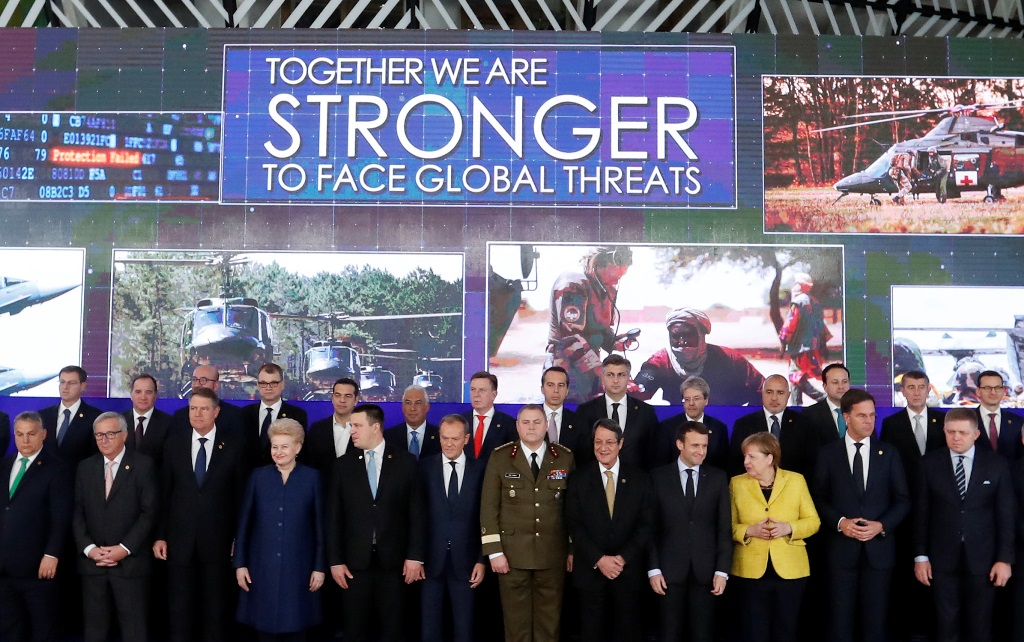PESCO: First Projects and the Search for (a Real) Breakthrough

PESCO: First Projects and the Search for (a Real) Breakthrough
Permanent Structured Cooperation (PESCO) will not bring a quantum leap in the military capabilities of the EU Member States. That would require more ambitious projects than those recently adopted. But the way PESCO is implemented can shape even now the future of EU-NATO cooperation and the role of the European Commission (EC) in defence policy. The initiative to tackle barriers to the rapid movement of troops and equipment within the EU (Military Mobility) could be developed in close collaboration between NATO and the EU, with the EC playing the leading role, as the first project of this kind in history.
First PESCO Project
There are two pillars of PESCO, the first being common commitments of states with regards to the financing, transformation, and technical modernisation of their armed forces, as well as defence cooperation with their EU partners. In the EU Council decision that established PESCO (11 December 2017), these have been indicated only generally, like “regularly increase defence budgets in real terms.”[1] For this reason, according to the “roadmap” for the implementation of PESCO, agreed by the Council on 6 March, the commitments will be developed in more detail and their implementation sequenced in two phases (2018–2020; 2021–2025). How states live up to the commitments will be subject to a regular review by relevant EU institutions.
The second pillar is collaborative capability-oriented projects undertaken by groups of willing states. Together with the roadmap, the Council agreed the first batch of 17 projects. Most of them (6) aim to facilitate and deepen cooperation in military education, training, logistics, and expeditionary missions, mainly through the standardisation of procedures, regulations, manuals, data exchange systems, etc. A further five projects focus on the development of new defence technologies: unmanned, maritime counter-mine vehicles, maritime surveillance systems, innovative energy sources for forward-deployed bases, harbour and littoral infrastructure-protection systems, and secure, digital military radios. The next two projects involve the development of new weapon platforms: armoured infantry vehicles and artillery, including ammunition. New multinational capabilities—medical support and a disaster-relief force package (2 projects)—and increased cooperation in cybersecurity by establishing a platform to exchange information on threats in cyberspace and rapid-response teams of cyber experts (2 projects) round out the list.
None of these projects comprises a breakthrough or creates multinational military units with a combat purpose or leads to a more advanced weapon platform. By November 2018, a second batch of projects is to be adopted and it is expected that it will involve a somewhat more ambitious undertaking. Until then, PESCO’s role as a mechanism to develop military capabilities in Europe will be limited and likely resemble the 2011 “pooling and sharing” initiative.
Military Mobility
Number-wise, with 25 participating states, the most distinctive PESCO project is the one dealing with facilitating the movement of troops and equipment within the EU (Military Mobility). Its aim is to tackle various barriers that delay or hamper the movement of troops, weapons, or other military equipment and supplies between the individual Member States. On the one hand, these barriers stem from the lack of harmonisation of national regulations and the lengthy procedures involved in, for example, crossing borders by military units or the movement of special military transports carrying large objects or dangerous materials like munitions. There are also many physical barriers: roads, bridges, tunnels, airports, and harbours unfit for military use (deploying heavy and large land vehicles, etc.). Or, there is simply no such infrastructure in locations that might play a crucial space in crisis scenarios requiring the rapid movement of forces.
At the same time, the speedy movement of troops, weapons, and equipment is a cornerstone of the credibility of NATO defence and deterrence policy in the context of Art. 5 scenarios (though, it also has a role in facilitating crisis-management missions as logistical delays in EU military operations in Africa and the NATO mission in Afghanistan showed). For this reason, following the 2014 Wales summit, NATO initiated a plan to increase military mobility. The Allies agreed that in a potential crisis involving Russia, the ability to quickly reinforce Eastern Flank NATO members with additional military units is necessary to effectively deter Russia from escalation. This reinforcement, however, is constrained by not only the Russian military potential in the region but also legal, regulatory, and infrastructure barriers to military mobility among the NATO members.
In December 2017, military mobility was included in EU-NATO cooperation efforts. It was rightly acknowledged that the Alliance on its own will not be able to reach tangible goals in an area where civilian instruments—such as those deployed by the EU—are needed rather than military ones. The potentially lead role of the EU in reinforcing military mobility in Europe was signalled not only by the launch of the respective PESCO project but also the presentation on 28 March of an Action Plan by the EC and the High Representative for Foreign Affairs and Security Policy Federica Mogherini. According to the plan, the responsibility for coordinating all initiatives in the field of military mobility will be taken up by the EU: the European Defence Agency and the EC together with the Member States. Further, the EC has announced that it will not only take regulative measures to harmonise regulations and norms crucial for military mobility across the EU but also to finance some investments in new infrastructure or adapt existing objects to military needs. It is not yet clear what the coordination will look like between NATO’s own initiative on military mobility, the joint EU-NATO action, the PESCO project, and the plan proposed by the EC. A lack of coordination, however, could easily lead to a failure of the entire concept of increasing military mobility in the EU.
Conclusions
It is now clear that PESCO will not lead to a quick breakthrough in European defence, given the goals and character of the first projects, as well as the sequencing of the implementation of the common commitments of states in their defence policy. For that, new projects are needed that would close the most urgent capability gaps of the EU Member States or involve the deeper integration and specialisation of national armed forces. This requires building understanding and the trust of states in cooperation in the PESCO format, which could take many years and is uncertain.
In the short run, however, how PESCO is implemented could shape future EU-NATO relations and the role the EC plays in defence policy in Europe. If the model to launch PESCO projects in close cooperation with NATO is sustained, then the concerns about a duplication or undermining of NATO actions by the EU may eventually turn out to be void. In the long run, this, in turn, can help increase the effectiveness of EU-NATO cooperation, re-launched by a joint declaration at the NATO summit in 2016. If the states turn out to be ready to establish big and ambitious capability-oriented projects, close cooperation between PESCO (and the EU defence review, CARD) with the NATO Defence Planning Process (NDPP) could indeed help reinforce the Allied defence and deterrence potential. If not, then the EU could still use PESCO to build the resilience of Member States to crises. As a newly declared goal of NATO, resilience assumes mostly actions towards the civilian sphere, such as developing civil-protection forces, or civilian-military cooperation in countering hybrid threats. It is in the interests of Poland and other EU states that consider the transatlantic partnership the primary vehicle to ensure European security to develop a concept in which PESCO is by definition implemented in close coordination with NATO.
Simultaneously, the EC can gradually build up its position as a stakeholder in defence policy in Europe. If the EC develops and continues to use regulative instruments (such as the ones proposed in the Action Plan) and financial tools (mostly the European Defence Fund, meant to help finance the development of defence technologies and some capabilities), then in the long run, the centre of gravity of the debate and actions regarding the development of defence capabilities in Europe could move from NATO (and individual capitals) to the EU.
[1] See: M. Terlikowski, “PESCO and Cohesion of European Defence Policy,” PISM Bulletin, no. 112 (1052), 17 November 2017.


